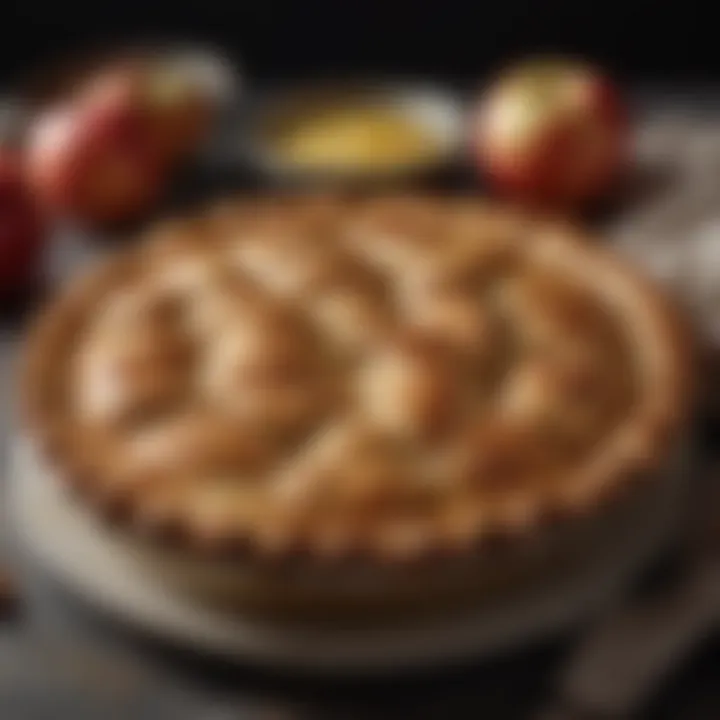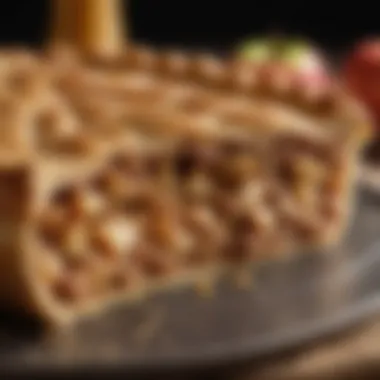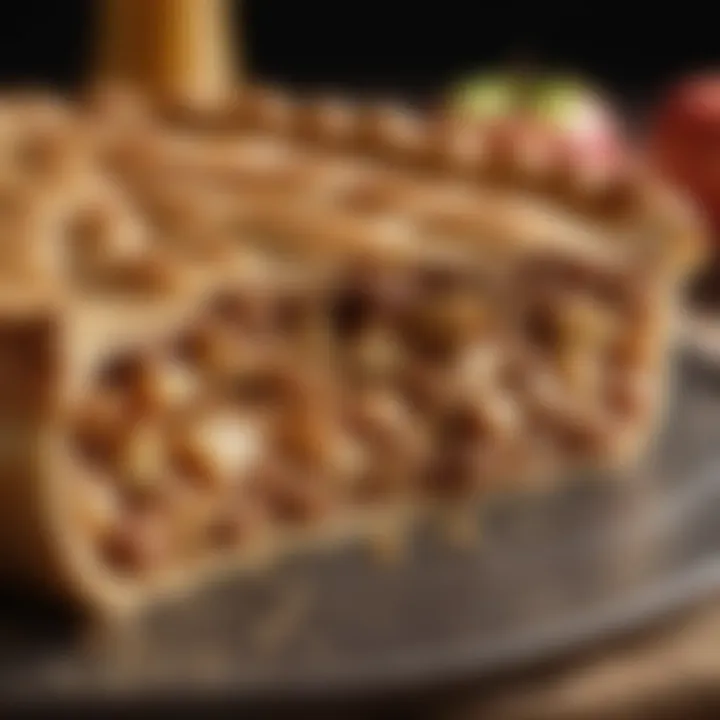Mastering the Art of Homemade Apple Pie


Recipe Overview
An apple pie, often hailed as a hallmark of traditional desserts, offers a distinct combination of simplicity and rich flavors. Mastering this classic involves just a few ingredients and basic techniques, making it an accessible option for many cooking enthusiasts.
- Portions: This recipe yields 8 servings
- Prep Time: Approximately 20 minutes
- Cook Time: About 45 minutes
- Difficulty: Medium
- Main Ingredients:
- Fresh apples (such as Granny Smith or Honeycrisp)
- All-purpose flour
- Unsalted butter
- Sugar
- Cinnamon
- Salt
Step-by-Step Instructions
Making an apple pie requires attention to detail. Follow these direct steps to ensure each phase leads to success.
- Prep the Ingredients:
- Make the Pie Crust:
- Chill the Dough:
- Prepare Filling:
- Assemble the Pie:
- Add Top Crust:
- Bake:
- Cool and Serve:
- Start by washing, peeling, and coring about 6 to 8 apples. Slice them thinly to promote even cooking. Optionally, you can squeeze in some lemon juice to maintain freshness.
- Combine 2 ½ cups of all-purpose flour with 1 cup of unsalted, cold butter. Mix until textures resembles coarse crumbs. Add a pinch of salt and about 5-8 tablespoons of ice water, just enough to bring the dough together.
- Wrap the dough in plastic wrap and refrigerate it for at least 30 minutes. This solidifies the butter, which can create a flakier crust.
- In a large mixing bowl, combine the sliced apples, ¾ cup sugar, 1 teaspoon ground cinnamon, and a dash of salt. Toss to coat.
- Roll out half of the chilled dough into a 12-inch circle, and place it in your pie dish. Pour the apple mixture into the crust.
- Roll out the second half of the dough similarly. Either cover the pie fully or make a lattice top by cutting strips of dough and weaving them.
- Preheat your oven to 425°F (220°C). Bake for about 15 minutes, then reduce the temperature to 350°F (175°C) and continue baking for an additional 30 minutes. This allows the flavors to meld beautifully.
- Allow the pie to cool on a rack for approximately 2 hours, giving the filling time to set before slicing.
Time-saving strategies
To reduce preparation time further, consider using pre-made pie crust or swapping fresh apples with canned apple slices.
Nutritional Information
Understanding the composition of your apple pie can guide those mindful of their diet.
- Calories per serving: Approximately 320
- Protein: 2 grams
- Total Fat: 16 grams
- Carbohydrates: 45 grams
- Notable Nutrients:
- Apples provide dietary fiber, vitamin C, and antioxidants.
- Cinnamon is linked to anti-inflammatory properties.
Quick Cooking Tips
Thoughtful preparation can enhance time-effectiveness:
- Use kitchen gadgets such as a food processor for quicker dough mixing.
- Organize your workspace for efficient motion; keep separate bowls for trash and compost.
- Consider substitutions. Pecans can add crunch while honey can send a different sweet note to your filling.
Related Recipes & Variations
For a complete dessert experience, consider
- Vanilla Ice Cream or Whipped Cream to elevate the pie.
- Explore variations like Dutch Apple Pie by adding a crumb topping or experimenting with nuts in the filling for texture.
- Create a gluten-free version by using gluten-free flour for the crust.
Maintaining balance between tradition and innovation will help you find joy in preparing and sharing apple pie with others.
Building skills in the kitchen not only serves practical purposes but also offers personal satisfaction.
Prelude to Apple Pie
Apple pie stands as one of the quintessential desserts in many cultures, resonating far beyond its simple ingredients. Its significance lies not just in its taste, but also in its rich historical background and deep cultural ties. This section delves into these elements, offering a substantial framework for understanding apple pie's role in culinary tradition. In this guide, experts and novices alike will find insights that not only enrich their appreciation of the dish but also inform their preparation techniques.
Historical Context
The origins of apple pie are intriguing. The earliest known recipes for fruit pie date back to the Romans, who created fruit-filled pastries that may have resembled modern pie crusts. However, apple pie as we recognize it exploded in popularity in the 16th century, particularly in England. Cookbooks from that time showcase the rederition of apple desserts, documenting variations up until the industrious colonial American period.
Culinary historians often point to quick adaptations that spawned distinct styles of this beloved dish. In a diverse society that included many European cultures, apple pie gained numerous interpretations reflective of regional cooking practices. By the 19th century, the dessert effectively transformed into a staple of holiday and family gatherings.
Cultural Significance
Apple pie transcends mere sustenance; it has become a cultural icon. Phrases like “as American as apple pie” hint at the dish’s place as a national symbol, representing concepts of home, comfort, and tradition. It often marks celebrations, bringing families together at seasonal events such as Thanksgiving, thus weaving itself into the fabric of American life.
The catchphrase also often filters into various the media, influencing art, literature, and song - amplifying its cultural presence. Joint gatherings involving baking or sharing apple pie enhance communal bonds and evoke nostalgia, as many couples and hospitality enthusiasts view the process of making pie as both an art and a labor of love.
The cultural importance of apple pie is not merely in its taste but in the comfort and connection it fosters between people.
Essential Ingredients
The success of an apple pie hinges significantly upon the careful selection and preparation of essential ingredients. Each component contributes uniquely to the final product, shaping both the flavor and texture. Understanding the specific roles of these ingredients can enhance the overall cooking experience and the resulting dessert.
Types of Apples
Choosing the right type of apple is crucial for achieving the desired taste and texture in your pie. Differences in sweetness, tartness, and firmness will influence not only the flavor profile but also how the fruit holds up during baking.
Honeycrisp
The Honeycrisp apple is renowned for its balanced sweet-tart flavor. It has a distinctive juicy texture that remains crisp throughout baking, making it an attractive choice for pies. One of its key characteristics is the ability to hold its shape and not become mushy when heated. This is especially advantageous in apple pie, where one wants clear slices filled with distinct pieces of fruit rather than a mushy filling. A consideration to keep in mind is its sometimes high price, which can be a disadvantage for budget-conscious bakers.


Granny Smith
Granny Smith apples are favorite among many pie-makers because of their sharp acidity and firm texture. This apple type offers a tangy contrast that works well with sweeteners in the filling, balancing the overall sweetness of the dessert. The bright green color adds visual appeal too. However, since they're quite tart, one should take care in adjusting the amount of sugar used in the recipe; otherwise, the pie could end too sour for some palates.
Braeburn
The Braeburn variety combines both sweetness and acidity, offering a unique flavor profile. Its dense and crisp flesh stands up well to baking. This apple brings a pleasant aroma to the pie, which contributes to a homey and inviting scent as it bakes. However, availability may vary by season, making access sometimes tricky.
Sugar Variations
The type of sugar used can drastically alter the character of your apple pie filling. Sligh variations not only enhance flavors but can also impact the overall sweetness, so careful selection is necessary.
Granulated Sugar
Granulated sugar is a classic choice for sweetening pie fillings. It dissolves easily in the liquid released by the apples during baking. Its clean sweetness pairs nicely with the natural flavors of the apples, allowing their taste to shine. Despite its efficiency, one must consider that it does not bring any additional flavors or depth, a point is worth considering when creating a more complex flavor profile for the pie.
Brown Sugar
Brown sugar provides distinct molasses undertones, adding depth and richness to the filling. Using this sugar type can enhance caramelization as the pie bakes, giving the crust and filling a more complex and appealing appearance. It is essential to balance it with simpler sugars if the pie is exceedingly sweet, as brown sugar may make the overall filling cloyingly sweet if too much is used.
Honey
Honey offers a unique and natural sweetness, presenting a healthier option for those wanting an alternative to refined sugars. It imparts its own distinct flavor, which can add complexity to the filling. Furthermore, honey can contribute to the golden browning of the crust, enhancing aesthetics. However, measuring the right amount becomes more critical because honey is sweeter by volume than regular sugar, which might lead to oversweet pies if miscalculated.
Spices and Flavorings
The addition of spices and flavorings elevates basic apple pie and can turn it into an exceptional dish. They collectively create a warm and inviting profile, enhancing the overall experience of consuming the pie.
Cinnamon
Cinnamon is almost an indispensable spice for apple pie. It complements the sugar and apples seamlessly and helps bring out their natural flavors. This spice embodies a warm, comforting aroma. Using it not only elevates flavors but also contributes to the overall sensory enjoyment of the pie. A point of caution: using excessive amounts can lead to an overpowering taste experience, which might emphasize bitterness.
Nutmeg
Often paired with cinnamon, nutmeg introduces nuanced and earthy tones to the flavor palette. A small pinch can enhance the dessert’s complexity and warmth. Its use should be subtle, as a heavy hand with nutmeg could easily overshadow the natural apple flavors and find the pie straying toward spicy than pleasantly aromatic.
Lemon Juice
Lemon juice adds brightness, which helps to balance the sweetness often found in apple pies. It prevents the apples from browning and maintains their fresh appearance. Adding the right amount helps highlight the apple flavors without overwhelming the overall sweetness. Too much lemon may swing the dessert from a sweet harmony to one that leans on sourness abruptly.
Choosing the Right Flour
The flour choice influences the pie crust's texture and strength. Each type varies regarding fat content and protein, thus impacting the texture.
All-Purpose Flour
All-purpose flour is the safest bet for creating a well-balanced pie crust that is neither too tender nor too tough. Its moderate protein levels yield a good pastry texture. This versatility makes it a popular choice among many bakers. One downside can be its inclination to produce less flaky layers when compared to other specialized flours when used without any alterations.
Whole Wheat Flour
Whole wheat flour introduces a nutty flavor and increases nutrition by providing more fiber. This enhances both the crust taste and flavor profiles, leaning towards a more wholesome quality. However, whole wheat flour may result in a dense pie crust if not incorporated correctly, affecting the lightness of the finished product.
Gluten-Free Options
Numerous alternatives exist for gluten-free baking, making it accessible for those with allergies or sensitivities. Options such as almond flour or coconut flour create unique textures and flavors. Yet, one must be cautious, as many of these alternatives might work better when blended with traditional flours to ensure structural integrity.
Butter vs.
Shortening The debate between butter and shortening for making pie crust swirls in many kitchens. Each option will leans different qualities and unique results.
Using butter generally results in richer flavors due to its dairy content. Additionally, butter helps achieve a flakier crust owing to its water content, which converts to steam during baking, creating those beloved flaky layers. Yet, its melting point is lower, requiring careful handling to keep the dough from becoming too warm.
In opposition, shortening creates a tender and less flaky crust due to their fat content properties, which can be useful for a different texture. While shortening does also create a soft texture, flavors might suffer, mostly due to its lack of flavor complexity found in butter.
Amidst the advantages and disadvantages of these fats, many culinary enthusiasts opt for a blend to secure a balance of flavor and texture.
Pie Crust Preparation
The foundation of a good apple pie begins with the crust. A well-prepared pie crust is crucial as it influences texture, flavor, and overall appeal. This section dives into the essential steps of preparing a pie crust, highlighting techniques that contribute to an ideal bake. An understanding of each element in pie crust preparation facilitates the creation of a pastry that perfectly complements the apple filling.
Making the Dough
Mixing Techniques
Mixing techniques play a pivotal role in how your pie dough comes together. The two most common methods are the rubbing method, where flour and fat are combined by hand to create a crumbly texture, and the food processor method, which quickly integrates the ingredients.
The key characteristic of these techniques is that they allow for full control over the dough’s consistency. The rubbing method is particularly beneficial for incorporating just the right amount of fat with minimal handling, which helps prevent the dough from becoming too tough. However, a challenge is the risk of incorporating too much air or producing uneven bits.
On the other hand, the food processor methods are popular due to their speed. The blending happens quickly and evenly, which ensures a consistent dough, yet it can easily over-mix, leading to a dense crust. Therefore, it is wise to monitor the mixing closely and handle the dough with care even during preparation.
Chilling the Dough
Chilling the dough is an often underrated, yet vital, step in pie crust preparation. The process of refrigeration solidifies the fat within the dough, resulting in a flakier crust after baking. The key characteristic of this chilling period is the rest it provides; by allowing the gluten to relax, the dough becomes pliable and easier to roll out.
This step is indeed beneficial for success. Furthermore, chilling helps to prevent shrinkage in the oven, which maintains the structure of your pie crust. However, one must be mindful of the duration. If you chill it for too long, the dough can become overly firm, making rolling more challenging. A typical recommendation is to chill for a minimum of thirty minutes before rolling.
Rolling Out the Dough
Once the dough is appropriately chilled, rolling it out is the next step. This process should be done on a lightly floured surface to avoid sticking. Aim for an even thickness; too thin can lead to breakage, while too thick results in an unpleasant chewiness. Work carefully to maintain the dough's integrity, and use gentle, even pressure.


Prebaking the Crust
Prebaking can enhance the pie crust texture and setup the base for the filling.
Blind Baking
Blind baking refers to pre-baking the crust before it gets filled. This technique helps to create a better texture and can prevent a soggy crust in the finished pie. The unique feature of blind baking is the step of using pie weights or dried beans to maintain the shape of the crust while it bakes.
This can be advantageous for recipes with moist fillings, ensuring that the crust stays crisp and retains its form. Disadvantages can include added time to the baking process, and needing to monitor, lest the crust brown too much during this initial phase.
Preventing Sogginess
Preventing sogginess is a related concern that addresses the tender balance of crust and filling. Strategies include using a thicker crust base and ensuring the filling is cooked to avoid excess moisture being soaked into the crust. Also consider the use of a layer of parchment paper or cornstarch in the bottom before adding the filling. This uniqueness is instrumental in achieving that ideal texture without compromising flavor.
Apple Filling Preparation
Preparing the apple filling is a critical step in making an apple pie. It not only influences the flavor profile but also the texture of the final product. Each ingredient you use plays a significant role. Choosing, preparing, and seasoning your apples properly ensures the pie is both delicious and visually appealing.
Preparing the Apples
Choosing the right method for preparing the apples shapes the outcome of your pie. Slicing or chopping the apples wrong can lead to uneven cooking at baking time.
Peeling and Slicing
Peeling and slicing apples is essential. It enhances their ability to absorb flavors from sugar and spices. By removing the skin, you allow for each apple slice to interact with other ingredients more effectively, ensuring better flavor distribution.
This choice of peeling and slicing apples is popular because it offers a smoother texture to the filling. It also allows for quicker cooking during baking, which can be vital if you have a preferred apple type or variety that takes longer to cook. One of the unique features here is that, depending on the apple varietal you choose, the slicing thickness can vary. Thinner slices can often give a jam-like consistency, while thicker ones contribute to a more rustic feel. However, you need to be cautious of how you slice because preaatively cut apples might break down too much in the oven, leading to a mushy filling.
Proper preparation method is key to achieving the perfect texture in your pie filling.
Tossing with Sugar and Spices
Tossing the prepared apples with sugar and spices like cinnamon enhances their flavor significantly. This step sets the base flavors of the pie and aids the caramelization process while baking. Using sugar helps to draw moisture from the apples and create a syrupy filling; meanwhile, spices like cinnamon and nutmeg add warmth.
Currently,tossing is a beneficial method because it ensures that each slice is seasoned properly. The key characteristic of this tactic is that it addresses the balance between sweetness and tartness efficiently. However, incorporating too much sugar or vice-versa can be a danger here. More sugar creates a risk of very sweet fillerg while less may risk under-seasoning. Thus, understanding your apple choice is fundamental in this process, which determines how much sugar you will need for balance.
Choosing Add-ins
Using add-ins can elevate your apple filling further. While optional, they contribute texture, flavor, and complexity. Here, we consider nuts and raisins as potential components.
Raisins
Raisins are often selected for their intense sweetness and chewy texture. They expand beautifully while baking, absorbing the flavors from the apples and spices. This aspect makes them a desirable add-in choice because they offer contrasts to the soft apples.
A unique feature of including raisins is their historical significance in baked goods, bringing with them cultural roots. Although beneficial, adding too many raisins can overpower dominant apple flavors. It is essential to find a balance to ensure the flavors weave together subtly.
Nuts
Nuts present another opportunity for enhancement in your filling. Walnuts or pecans can be particularly pleasing, providing a crunchy contrast to the soft apples. Nuts add elements of richness and depth, enriching the pie’s overall experience.
The nuttiness acts as a flavor counterpoint to the sweet apples. However, while they fill out the mouthfeel wonderfully, they can also overshadow other flavors if too abundant. Thus, using nuts in moderation often provides the best results. This holistic selection of ingredients fosters a well-balanced pie that delights the senses!
This stage in apple pie making is just as essential as the crust preparation. Properly handled, the right fillings transform what might be plain into something extraordinary.
Assembling the Pie
Assembling the pie marks a critical stage in the journey of making an apple pie. This step determines not only how the pie looks but also how well it holds its shape and combines flavors. Attention to detail in assembly can enhance the aesthetic and functional aspects of the pie. Proper layering ensures that each bite is balanced with apple filling, sugar, and spices, creating a delightful tasting experience.
Layering the Filling
When it comes to layering the filling, the sequence plays a significant role. Start with a flavorful base layer to form a foundation; this could be a portion of apples lightly coated in sugar and spices. Place the slices in the crust systematically. This will ensure that every piece of fruit receives adequate sugar and spice blend, maximizing the flavor. Allow the filling to bulge in the center for a more appealing presentation.
Steps for Layering the Filling:
- Prepare Apples: First wash, peel, and slice apples until they're about a quarter-inch thick.
- Toss with Sugar and Spices: In a large bowl, toss the slices with your prepared mixture of sugar, lemon juice, and spices to coat evenly. This is essential.
- Begin Layering: Take a portion of tossed apples and layer it into the bottom of the pie crust. Overlap the slices for a thick and full filling.
- Continue Layering: Repeat the previous two steps until all apples are used. Make sure to treat each layer gently to not break the slices.
Lattice vs.
Solid Crust
The decision between a lattice or solid crust can dramatically alter your pie's overall appearance and texture. A lattice crust enables steam to escape during baking, which can lead to a firmer filling. It also provides a beautiful, classic look, often preferred during festive occasions. On the other hand, a solid crust offers a more simplified aesthetic, and the top can be stamped or slashed for decoration, ideal for those who prefer a straightforward approach.
Lattice Crust Considerations:
- Taste and Texture: Lattice lets the filling be a bit juicier, creating a desired contrast.
- Visible Filling: Offers a peek of the apple mixture through the crust.
Solid Crust Considerations:
- Cleanliness: No strands might be preferable for presentation.
- Protection: A solid top shields the filling from direct heat.
There is no absolute choice when it comes to crust preference; it often depends on personal taste and desired aesthetics. Regardless of the option you select, make sure the edges are crimped well to prevent any leaks during the baking process. Assuming these designs engages both the eye and palate, making the pie not just a dessert but a centerpiece.
Baking Process
The baking process is a critical step in making an apple pie. This is where all the preparation will culminate in a final, delicious product. Understanding the right parameters during baking enhances flavor and texture, ensuring that your apple pie is not only visually appealing but also very tasty. Mastering this process can elevate your apple pie from mediocre to remarkable.
Oven Temperature Guidelines
Choosing the correct oven temperature is paramount when baking an apple pie. An optimal baking temperature generally ranges between 350°F and 425°F. Most recipes suggest starting at a higher temperature of around 425°F and then reducing it after the initial cooking time. This method helps achieve a golden-brown crust while allowing the apples to cook thoroughly.


Maintaining a steady temperature ensures even cooking. If your oven has hot spots, consider rotating the pie halfway through the baking time. Using an oven thermometer can help ensure accuracy. Precise temperature management gives your pie its essential characteristics, allowing it to be both flaky and tender.
Baking Time Recommendations
Baking time plays a significant role, as underbaking or overbaking can lead to undesirable outcomes. Usually, apple pie requires about 45 to 60 minutes of baking. However, factors such as the thickness of your crust and the type of apples used can alter this duration.
It is wise to start checking the pie at the 45-minute mark. Here are some quick guidelines for ensuring that your apple pie is baked just right:
- If the crust is browning too quickly, cover the edges with foil.
- Look for bubbling juices in the filling; this suggests the apples have cooked adequately.
- A perfectly baked pie will also emit a warm aroma that fills your kitchen.
Checking for Doneness
Determining whether an apple pie is done can be a bit challenging. Here are basic indicators:
- Color: The crust should be a deep golden-brown.
- Bubbling: Juices should bubble through the vents or slit cut in the top crust.
- Apples: Fork-piercing should reveal tender apples without resistance.
To allow the pie to develop the best flavors, let it cool slightly before cutting. Proper cooling allows the filling to set, providing a cleaner slice.
The baking process not only enriches the flavors but also determines the structural integrity of your apple pie, making it crucial for both appearance and taste.
Advantages of mastering this stage include the confidence that comes from knowing how to tailor the bake to your personal preference. Consider experimenting with these recommendations to find your ideal process
Cooling and Serving
Cooling and Serving are key components often overlooked in the art of making apple pie. After the pie is baked, proper cooling is crucial; it affects texture, ease of slicing, and flavor balance. Allowing the pie to cool at room temperature permits the filling to set, preventing a soupy consistency when cut. Moreover, a warm pie that is served too quickly may result in scalding if not allowed to settle, making the experience less pleasant for pie enthusiasts.
When it comes to serving, the pairing of accompaniments can significantly enhance the enjoyment of the dish. The warming effects of a fresh pie combined with the right toppings contribute to its overall appeal. Keeping these elements in mind will elevate not just the pie itself but also the experience surrounding it.
Cooling Techniques
To cool the pie effectively, it should be placed on a wire rack. This allows air to circulate around the crust, which aids in achieving a crisp finish. Placing a pie on the counter or working area directly can trap heat and moisture. Generally, cooling for at least 2-3 hours becomes advisable before serving.
If time is short, try the refrigeration method for a more rapid cooldown. Unlike leaving it to cool naturally, refrigeration can alter the texture slightly. Therefore, temperature must be monitored to ensure that it does not result in a cold pie instead of a complement to a warm serving.
Serving Suggestions
When it comes to serving apple pie, here are two classic options that enhance the flavor profile.
With Ice Cream
The presence of ice cream offers a rich and creamy texture that defines this popular pairing. Vanilla flavored ice cream coincides beautifully with the warm spices present in the pie. This temperature contrast—from hot to cold—stimulates the senses and elevates the overall experience. Ice cream introduces a mellowness, enhancing the sweetness and balancing tartness from the apples. However, it is essential not to let it melt too quickly onto the pie, which can make it overly soggy.
Whipped Cream
Unlike ice cream, whipped cream adds lightness to your serving. Its airy texture complements the dense yet tender filling. Moreover, it allows for quick application because it does not require any melting or additional preparation. Often, a simple addition of vanilla flavor to the cream can bring targeted taste enhancements. Whipped cream should ideally be added just before serving. However, care must be taken to avoid overdosing cream as this may overshadow the satisfying flavors present in a well-made apple pie.
Common Mistakes to Avoid
When it comes to making a classic apple pie, understanding common mistakes can significantly enhance your baking experience. Identifying these pitfalls allows cooks, both novice and experienced, to produce a well-executed pie. Avoiding blunders not only saves time and frustration, but it also improves flavor and appearance. Here we will discuss two notable errors that commonly arise when preparing an apple pie: overworking the dough and under-seasoning the filling.
Overworking the Dough
Dough can be sensitive to handling. Overworking it, especially when making pie crust, leads to tough and chewy pastry. The key component is the gluten formation that occurs when flour is mixed with water. The more you handle the dough, the more the gluten develops. While some elasticity is helpful in certain recipes, pie crust should be flaky and tender.
Techniques to avoid overworking include:
- Using the right mixing method: Rather than stirring aggressively with a spoon, consider using a pastry cutter or your fingers to combine the fat and flour. Work quickly and efficiently.
- Limit kneading: When forming the dough, just a few gentle folds are enough. A quick press and shape will maintain that desirable texture.
- Chill: Chilling the dough both before and after rolling out helps to reduce elasticity and solidify the fats, making it easier to handle without overworking.
Under-seasoning the Filling
Each component of your pie influences its overall taste, especially the filling. Apples on their own can be slightly bland depending on variety and ripeness. If the filling lacks seasoning, the result is lackluster, failing to highlight the fruit's natural sweetness and acidity. Seasoning spices like cinnamon add warmth, while a touch of sugar enhances the flavor effectively.
A couple of thoughtful suggestions include:
- Perfect Balance: Experiment with the amounts of sugar and spices until the flavors complement the apples appropriately. Taste the mixture before assembling, adjusting as necessary.
- Consider the Complexity: Adding lemon juice contributes brightness and helps to prevent browning. A pinch of nutmeg can provide an unexpected depth.
Ultimately, paying attention to these common mistakes will ensure that your apple pie not only looks appealing but also delivers on flavor.
Remember, baking is as much about science as it is about art; the right techniques lead to consistent results.
Avoiding these mistakes not only troubleshoots potential failures. Instead, it contributes to making a classic dessert revered by many.
Final Thoughts
In any culinary adventure, acknowledging the final thoughts encapsulates both the completion of a dish and reflections on the process involved. Crafting an apple pie is an expression of creativity and practical skill. Understanding the essential elements, along with variations and proper storage techniques, enriches the pie-making experience.
Variations on the Classic Recipe
Variations allow cooks to explore personal tastes and seasonal offerings. For example, spices like cardamom or ginger can bring a fresh twist. Using different types of apples changes the flavor significantly—mixing tart Granny Smith with sweet Honeycrisp creates depth.
Some choices include:
- Dutch Apple Pie: Features a crumble topping instead of a traditional crust.
- Caramel Apple Pie: Incorporate caramel for added sweetness and richness.
- Savory Options: Try cheese or herbs alongside apples for an unconventional approach.
These variations not only offer unique flavors but also broaden your skills and zest for baking.
Storing Leftover Pie
Proper storage is crucial for maintaining the pie’s flavor and texture after baking. An unopened pie lasts for several days at room temperature, while refrigerator storage helps preserve freshness longer. Here are some recommendations:
- Room Temperature: Store pie at room temp if consumed within three days.
- Refrigeration: For extending the shelf life, refrigerate, ensuring it’s well covered; plastic wrap or foil works well.
- Freezing: If you can’t finish the pie, it can be frozen for up to three months. Ensure to wrap it tightly in plastic before placing in a freezer bag.
Remember, reheating can reinvigorate flavors. Simply warm in an oven and serve!
Final thoughts on making an apple pie demonstrate that creativity and practicality go hand-in-hand. With the learned techniques, suggestions for variations, and storage strategies, one can enjoy delicious homemade apple pie time and again.







